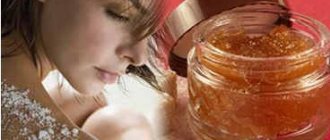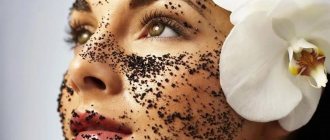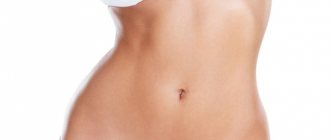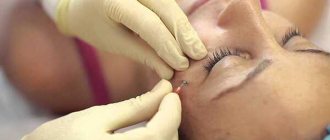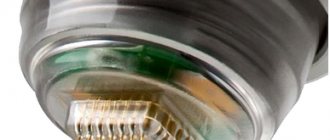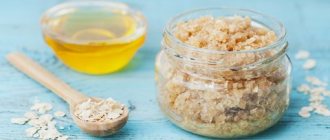Exfoliants are an extremely multifunctional thing. Rough brushes and scrubs not only remove dead skin cells and make the skin smooth, but also serve as an excellent prevention of cellulite and ingrown hairs.
The main question that arises when it comes to body scrubs is: how often can you use them? Corey L. Hartman, board-certified dermatologist and founder of Skin Wellness Dermatology, says mechanical exfoliators are recommended to be used no more than twice a week, while chemical body peels can be used almost every day. This regimen is good for most skin types, but no one can guarantee that it will suit you. In this question, it is best to base yourself on your skin type and the goals that you set for the cosmetic product.
Homemade scrub
In order to get smooth skin, it is not at all necessary to buy a scrub in the store. There are a great many recipes for homemade peelings floating around the Internet, but the most popular of them is perhaps coffee peeling. Mix the grounds (you can also use salt or sugar instead) with one of the base oils (olive, jojoba, almond or grape seed oil are suitable) in a 1:1 ratio and apply the resulting mixture to the skin. Those who like to experiment can add a few drops of essential oil or a spoonful of honey to their scrub.
Why is body exfoliation so important?
Exfoliation removes dead skin cells from the surface that can cause skin to appear dull or dry. Not only does it refresh and renew the outer layer of skin, but it also increases blood flow and collagen production. Regular exfoliation improves your skin's ability to absorb moisturizer and other products and brightens your skin tone. These benefits apply to both your body and face.
The key to safe and effective exfoliation is choosing the right product. You may already know the difference between mechanical and chemical exfoliation and have probably chosen a product for your face. When it comes to body exfoliation, there are several options. Body scrubs are the most popular. You can even try mechanical exfoliators, such as an exfoliating glove, brush, or sponge.
Dry brush
Followers of Ayurveda are very fond of using a dry brush instead of a scrub. Exfoliating your skin with this accessory has been proven to improve blood circulation, promote lymphatic drainage, and even increase energy. Brush bristles are usually made from synthetic nylon or natural boar bristles. Rarely you can find options with copper threads, but they are intended exclusively for very rough areas of the body, as they are very tough.
When using a dry brush, be extremely careful: try not to put pressure on the tool, but you shouldn’t be afraid of it either. Balance is important.
Skin exfoliation: everything you wanted to know - tips from a cosmetologist
Restore smoothness, softness, elasticity and a beautiful shade to the skin - all this can be done with exfoliating procedures.
BeautyHack asked a cosmetologist where to start and how to properly remove dead cells from different parts of the body.
Irina Nikolaevna Vasilenko
Cosmetologist and plastic surgeon
Why is it necessary to cleanse the skin of dead cells?
Exfoliation is an important step in skincare that needs to be done regularly. When the skin gets rid of dead cells, it makes room for new ones - they are renewed approximately every 1-2 months, depending on age and type. As they accumulate, dead particles clog the ducts of the sebaceous glands, cause the formation of blackheads and inflammation, and also lead to the appearance of dry areas, uneven color and dullness. A dense layer of dead cells prevents the skin from getting the most from care products - without proper cleansing, not a single cream will work well.
How often should you exfoliate?
How you cleanse your face will depend on your skin type and the type of exfoliator you use. For example, acid-based lotions can be used daily, and mechanical peelings (scrubs and gommages) - 1-3 times a week. Chemical and hardware procedures are recommended no more than every one to two months, depending on the depth of exposure.
As for the skin of the body, it can be exfoliated with various scrubs. If it is dry, it is enough to use the product once a week - choose delicate textures. Oily skin can be cleaned every two to three days - larger particles are suitable for it (find the 6 best scrubs for the summer here).
How to choose exfoliating products for different skin types?
To cleanse normal skin, you can choose any peeling or scrub: chemical, with abrasive particles, combined exfoliants and any other means. Oily types are also easy to deal with - scrubs with enzymes, oatmeal or clay based are suitable. You need to be careful with sensitive or acne-prone skin - these types can be exfoliated no more than once a week with chemical peels - it is not advisable to use products with coarse abrasive particles.
What salon treatments can you choose to exfoliate your skin?
To cleanse your skin of dead cells, you can sign up for a peeling procedure - depending on the method of exposure, they are divided into several types:
Chemical –
Removal of contaminants occurs using special compounds containing acids, such as glycolic, lactic or salicylic. When they get on the skin, they dissolve the bonds between keratinized scales and promote cell renewal. Depending on the acid chosen, the procedure also combats various deficiencies. And the stress that the skin experiences during the peeling process helps to activate its protective functions.
Mechanical - sea salt, sugar crystals, crushed apricot kernels, nut shells, and polyethylene granules are used as abrasives in this procedure - this type of peeling accelerates the exfoliation process and enhances microcirculation. Sensitivity and dry skin may be contraindications for it.
Ultrasonic – superficial peeling that exfoliates dead skin cells using ultrasonic waves. It is considered one of the most gentle methods - the procedure helps fight acne and restores skin moisture levels. You can do it no more than twice a month.
Laser – destruction of the upper stratum corneum occurs due to the impact of a laser beam on the skin (the expert talks about laser procedures and resurfacing in this material).
Should you exfoliate your hands and feet?
The skin of the entire body needs care. To cleanse your hands, you can use scrubs with large abrasive particles or sign up for procedures such as dermabrasion, laser resurfacing or acid-based peeling. For the latter, AHA and TCA acids are more often used - such care removes signs of age-related changes, brightens the skin and makes it smoother and more elastic.
It is also important to exfoliate your feet - rough areas on the heels have never graced anyone. This can be done at home. Today, in the lines of different brands you will find acid-based scrubs, peelings and masks that effectively cleanse the skin.
How to care for your skin after exfoliation?
Any peeling is a certain stress for the skin, so proper care is important to restore it and avoid unwanted complications. The most important rule is intensive hydration. You can apply soothing or restorative masks, nourishing creams and lotions - this should be done every time you feel dryness or discomfort (you will find the 15 best Korean fabric masks for moisturizing here). After any peeling, you must use sunscreen.
When should the procedure be abandoned?
The main and general contraindication for any type of exfoliation is a violation of the integrity of the skin, as well as various types of diseases: infectious, oncological, herpetic rashes, allergic and others. Some types of peeling cannot be done during pregnancy and lactation.
Removing dead cells or exfoliation is one of the important stages of skin care, but this is an individual process, so you need to treat the procedure carefully and monitor your reaction - the result and the absence of side effects will depend on this.
Classic scrub
If you don’t want to bother making your own scrub, you can easily buy a ready-made one. Cosmetics brands offer many variations on the theme, ranging from organic formulas to those ideal for sensitive skin. However, even the mildest body scrub should not be applied to the face.
“Body exfoliators are often thicker in consistency and contain high concentrations of acids, which can cause irritation on the delicate skin of the face,” says board-certified dermatologist Rachel Cochran Gathers. “However, face scrubs are too gentle to be beneficial.” tangible benefits to the skin of the body.”
Pathological processes in the skin
What all 4 subtypes have in common and what needs to be taken into account when choosing a peel for sensitive skin:
- Broken skin barriers , namely:
- outer barrier – amount and composition of sebum
- Skin pH
- internal (epidermal barrier) – lipid substance of the epidermis
Any substance applied to the skin falls inside faster and in a larger volume than normal. The result is an inflammatory reaction - redness, peeling and discomfort. And in the case of a number of peelings, there is immediate irritation of the skin, even to the point of crusts and subsequent extensive peeling.
- Increased sensitivity of nerve endings in the skin
The perception of a sensory impulse (applying cosmetics, washing with water, temperature changes, etc.) is perceived as painful, as an unpleasant sensation.
- Vascular component
The vascular walls are thinner and more fragile, which is the reason for their increased permeability - sweating, swelling, redness of the skin and even the visual appearance of dilated blood vessels on the skin.
Identifying and eliminating the main triggers of this process is an important point, but not the goal in itself of correcting sensitive skin.
Chemical peeling
Acid body peels are a fairly rare product, so they can only be found from professional brands. Just like similar facial products, they are divided into two categories: with alpha (AHA-) and beta hydroxy acids (BHA-). AHAs (which include lactic and glycolic acids) are known to have stronger moisturizing effects. "They exfoliate and hydrate the skin at the same time, making them suitable for most skin types," says board-certified dermatologist Mona Gohara, MD. BHA acids (a prime example is salicylic acid) have a better effect on areas prone to oiliness, which is why they are most often used in products for problem skin.
How to use
Dr. Schultz recommends exfoliating only once a day and not rubbing the skin. “With chemical exfoliants, a little is good, but more is usually not better because if you overdo it, you create irritation,” he warns. “So start with less strength, use a little (less is more) and no more than once a day.”
Dr. Nussbaum adds a few more tips. "To avoid overdoing it, start by exfoliating once or twice a week, gradually increasing the frequency depending on the product you're using or your skin type," she suggests. “Over-exfoliation can lead to redness, inflammation, dryness and broken skin.”
Finally, apply moisturizer now that your skin is better able to retain moisture.
"I prefer moisturizers with hydrating ingredients that capture and attract moisture (hyaluronic acid absorbs 1,000 times its weight in water!) and emollient ingredients that help lock in moisture," suggests Dr. Nussbaum.
A few of our favorites? Neutrogena Hydroboost Water Gel Moisturizer, an oil-free gel moisturizer with hyaluronic acid, and CeraVe Moisturizing Cream, a fragrance-free moisturizer with skin barrier-strengthening ceramides and hyaluronic acid.
If you exfoliate in the morning, Dr. Nussbaum notes that it's important to apply moisturizer and sunscreen afterwards. She also recommends an antioxidant treatment such as Skinceuticals Phloretin CF. “This is my favorite because it contains a synergistic combination of vitamin C, phloretin, and ferulic acid, which fights environmental and UV damage,” she says.
Lemon Exfoliating & Hydrating Mask
Lemon contains acid that will help remove the top layer of the epidermis and thoroughly cleanse the skin.
Mix some unsweetened yogurt with lemon juice and apply a thick layer to your face. This mask can be kept for 5 to 15 minutes.
Mix a tablespoon of crystallized honey, 2 tablespoons of fine salt and a spoonful of lemon juice. Rub the resulting mixture with light circular movements into the skin for 2 minutes, then leave for 5 - 7 minutes and rinse with warm water. Dry your face with a clean towel and apply nourishing cream.
How to moisturize your skin after peeling
Since peeling is a fairly aggressive polishing procedure, it is completely normal for the skin to begin to react in the form of peeling on the 2-3rd day. Especially when deep peeling was performed in the salon, removing a significant layer of the epidermis.
On days 1-2, cosmetologists do not recommend even touching the skin, going outside, and even more so using any cosmetics. Only on day 3 can you soften the skin with a product based on hyaluronic acid.
A mask of their grape seeds, shea butter or fatty acids that are found in products of animal origin (pork lard, lamb fat) and vegetable (palm oil, soybean) have also proven to work well.
Don't miss the most popular article in the section: Facial massage according to the system of the Japanese doctor Asahi Zogan.
Honey exfoliating mask
Honey is antibacterial, antiviral and antifungal. It kills skin infections, eliminates acne, reduces inflammation and moisturizes. For an exfoliating mask, it is best to use honey in combination with baking soda or oatmeal. The components must be mixed in equal parts and distributed with soft circular movements throughout the face. Leave for 35 minutes and then rinse off with a soft sponge.
Mix a spoonful of liquid honey with ½ spoonful of cinnamon and nutmeg until smooth. Then spread the mask over your face with light massaging movements, avoiding the area around the eyes and wait about 15 minutes. After the time has passed, wash your face with warm (but not hot) running water.
Gelatin peeling mask for face cleansing
This mask perfectly cleanses the top layer of skin from impurities, eliminates dry cells and helps heal acne. To prepare it, you will need to combine a teaspoon of gelatin and 1 tablespoon of milk in a bowl. Mix well and place in a water bath until smooth. Then cool a little and spread on the face, paying special attention to the T-zone and chin. After 10 - 15 minutes, the mask will dry and you can carefully remove it. Wash off any remaining residue with a damp towel.
Exfoliating clay mask
Clay is an excellent skin cleanser of various impurities, which is why it is often used for deep peeling. To create a mask, you need to steam a tablespoon of clay with boiling water, then cool and mix in cucumber puree with a few drops of olive oil. Using light massaging movements, spread a thin layer on the face and leave for about 20 minutes. Rinse off with a sponge.
Causes of dry skin on the face
How to get rid of peeling skin on the face can be found out by establishing the main reasons why this happens. The main one is a lack of moisture caused by both internal and external factors.
External reasons include:
- exposure to frost, snowfall or rain;
- using soap to wash your face, which dries out the skin;
- the presence of alcohol in cleansing lotions and makeup removers;
- hard or hot water when washing;
- allergic reaction to dust, small particles, pollen.
Internal causes of dry skin include:
- hereditary predisposition;
- disruption of the sebaceous glands;
- reaction to various medications;
- seasonal vitamin deficiency.
Invigorating peeling face mask with coffee
Another fantastic natural exfoliator is coffee. It is rich in caffeic acid, which acts as an antiseptic on the skin and also increases collagen production. For the scrub, you will need to mix ½ tablespoon of ground coffee with 1 tablespoon of water or flaxseed oil. Apply to skin with light massaging movements for 30 seconds and leave for another 15 minutes. Then rinse gently with rose water.

